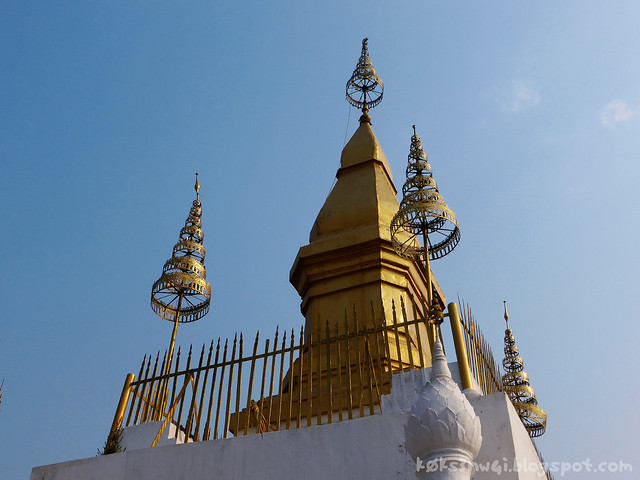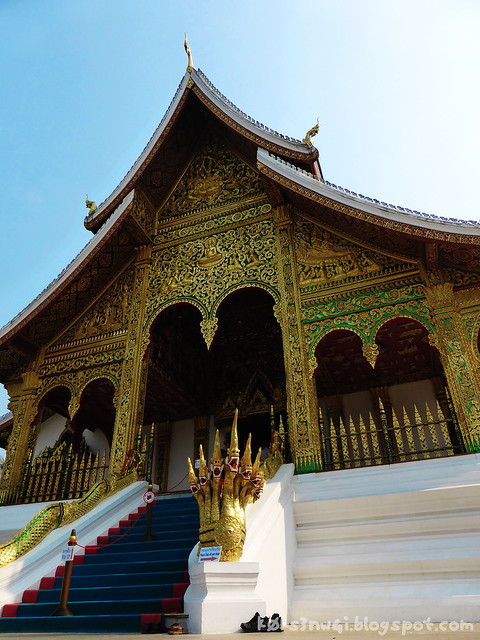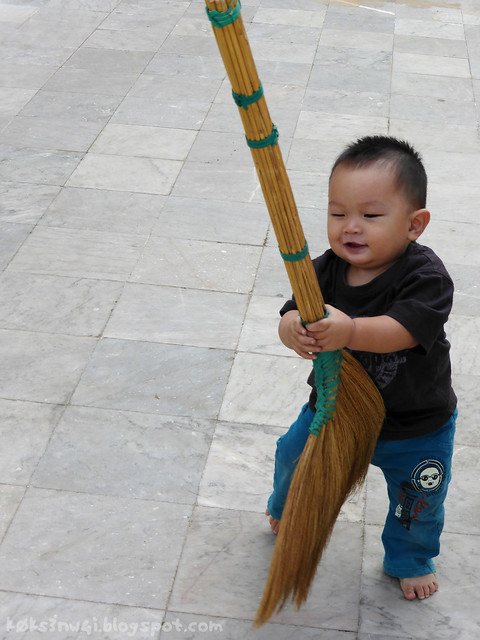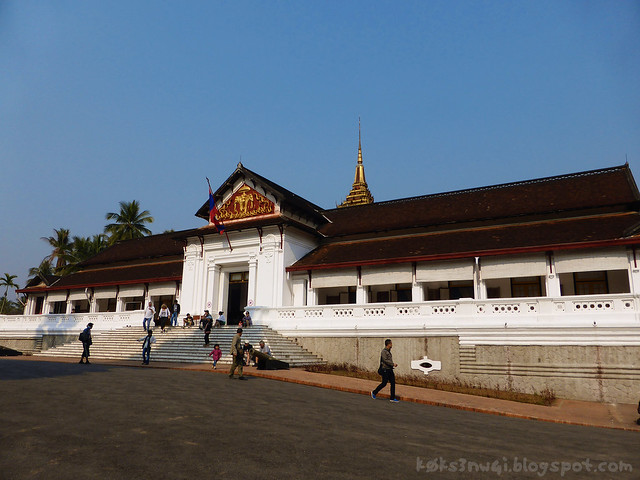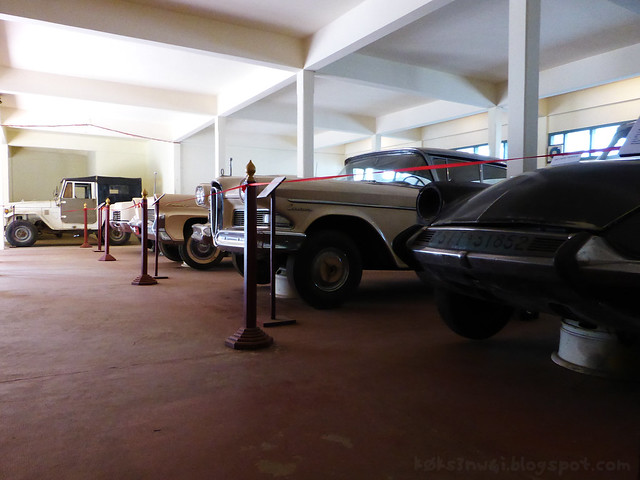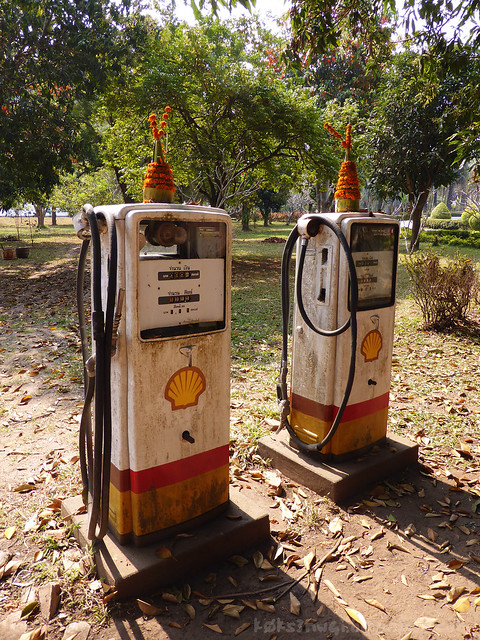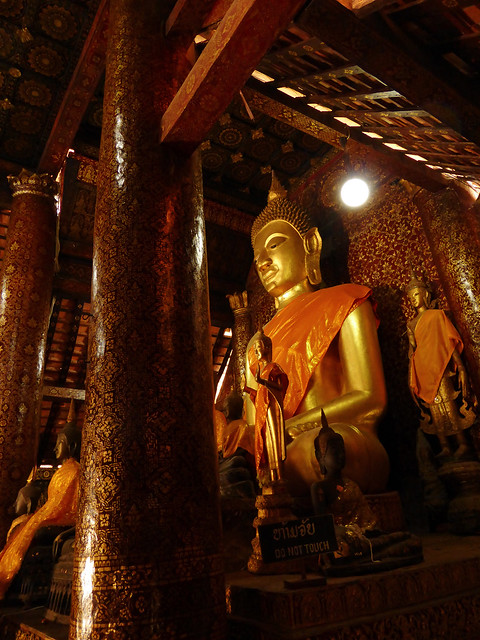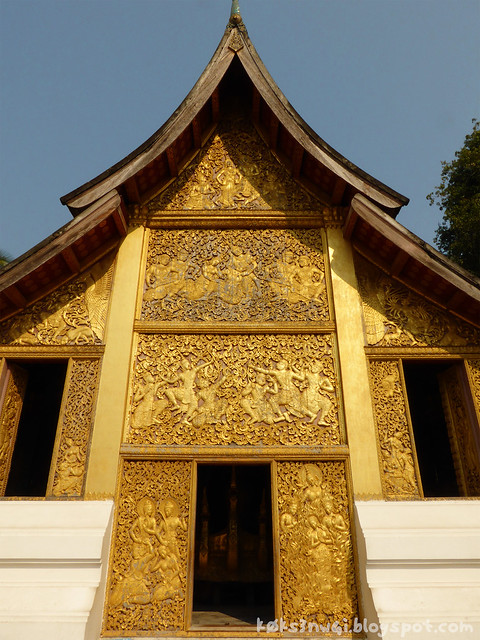"Absence makes the heart grow fonder, but it sure makes the rest of you lonely."
Charles M. Schulz
After our success with street food in Vang Vieng, we had grown bold. We relaxed our guards and started eating at any roadside stall that draws a crowd. To be honest, I am never particularly careful with what I eat because I reckon that after spending almost 3 years in India, my gastrointestinal tract must have cultivated a fortitude that can rival the digestive capacity of some species of pigs. My lady, on the other hand, have spent most of her adult life in Singapore, a city state that in which garbage is considered an endangered species.
Here's where we had dinner on our first full day in the city of Luang Prabang.
 |
| Smörgåsbord. |
Cheryl spotted this roadside all-you-can-carry-away-in-one-plate buffet at the mouth of an alleyway leading away from the Handicraft Night Market. At just 10,000 kip (1.25 USD or a little above 4 ringgit) per pop, it was real easy on my wallet.
 |
| Cheryl sealing her doom. |
Little did she know, she would came to regret this meal as it would make a reappearance later that night through the same orifice it went in. Cheryl, it seemed, had fallen for that commonest of calamities befalling travellers - food poisoning. The illness would go on to incapacitate her for the entirety of the following day, putting a crimp in our plans. Me? My burps tasted a little funny that morning but otherwise, all gears and cylinders were operating in pretty much the same way they always have.
As soon as day broke, I left our guesthouse to hunt for another place as our room was already booked other guests. Thinking that the room rates would be cheaper if I look outside of the central area, I headed out to Manomai Road where we passed many guesthouses on our arrival night. I saw that some street vendors there were hawking a fare familiar to me, so I had some.
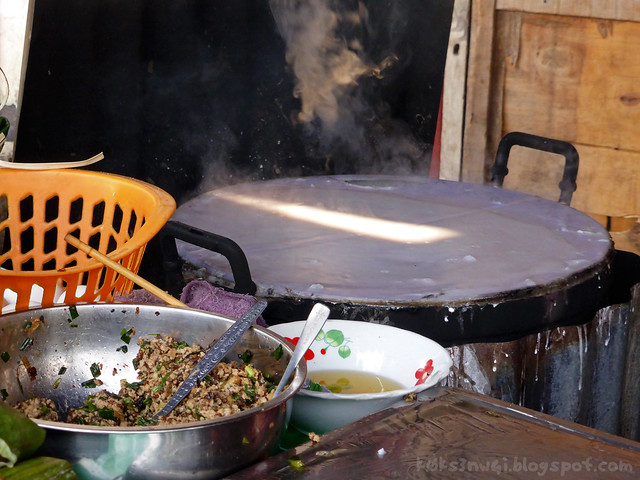 |
| Rice noodle sheet cooking on a hot plate. |
 |
| Breakfast! |
The vendor I bought my breakfast from couldn't not speak or understand English and my mastery of the Lao language begins at "sabaidee" and ends at "khawp jai", I did not find out what the Lao call it - but where I'm from, it's known as chee cheong fun. It's a kind of steamed rice noodle roll that's stuffed with minced meat or shrimp and is usually eaten with soy sauce. The one I had here was served with some sweet, fragrant oil with an overkill of fried onion garnish. It tasted amazing.
 |
| No matter where you are from, the desire to put silly clothes on your pets is universal. |
I finally found a place called P. P. Guesthouse that was situated right across the road from Wat Manorom which have an almost exclusively Lao clientèle. They also charge about 3 times cheaper than where we've been putting up our legs at in the previous two nights, in spite providing the same amenities (if not the same aesthetics). I immediately paid up for two nights and headed back to my ailing spouse at the Tha Heua Me Guesthouse to see if she was still alive (she was). With a bit of encouragement, I got her out of that her bed into a new bed across town, where she curled up to rest some more.
Not wanting to waste the day, I started exploring the area surrounding our new accommodation. As Wat Manorom was just opposite, I went to see to pay that a visit. While it is a well known local monument, it being situated far outside the the central tourist Disneyland meant that I did not have to pay an admission fee to enter.
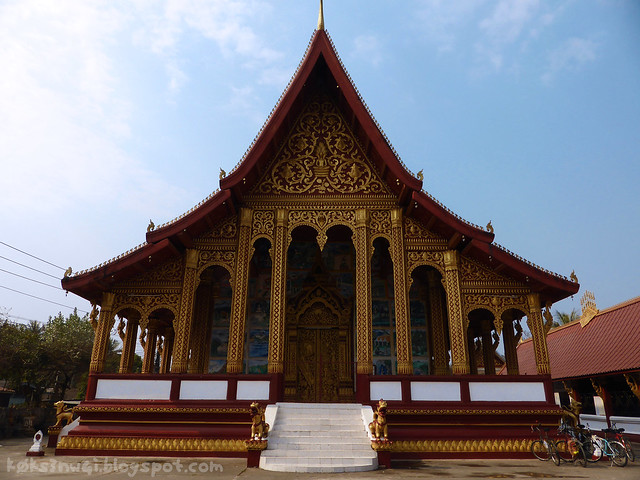 |
| The front of Wat Manorom. |
I can talk about it being being founded in the 14th century or about how it houses the oldest large Buddha statue in the city, but the most interesting I saw there was this monk leaning on a motorbike, smoking a cigarette.
 |
| So much for relinquishing earthly desires. |
Speaking of less than materialistic Buddhist monks, here's one playing with his phone while chilling out in the courtyard of Wat That Luang, a temple near Wat Manorom.
 |
| According to some Buddhist sects, playing Centipede is mindless enough to be considered meditation. |
Situated behind our new guesthouse is the UXO Lao Information Centre.
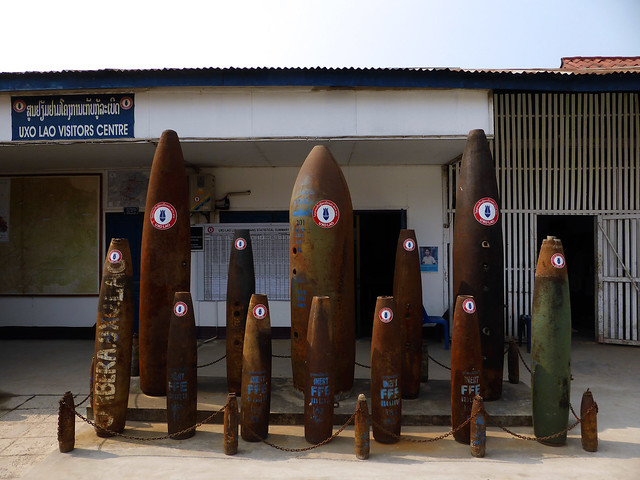 |
| Sure screams welcome to me. |
UXO stands for Unexploded Ordnance, and UXO Lao is the national bomb clearance operator that works to clean bomb contaminated lands to free them for agriculture, development and community purposes (schools, hospitals, temples, water supply, and so on). They also conduct educational risk-reduction programmes for the affected communities.
A stark information board right outside the Visitors Centre reveals some sobering statistics. More than 40 years after the Laotian Civil War, there are still casualties that resulted directly from the bombs that was dropped by the US and Laotian Air Forces. In the past 10 years, 29 people were killed while 36 were injured from live UXO's and chances are, the actual numbers may be higher as there are a lot of remote communities living far away from civilisation in this country.
 |
| It's mostly bombs inside. |
The flipside of those stats is how much good UXO Laos is doing for the people as they have cleared more than 29 million square metres of land, benefiting an estimate of half a million civilians since 1998. The exhibits at UXO Lao Visitors Centre were simple, blunt and filled with unconcealed resentment towards the US imperialists who turned their foreseeable future into a massive nationwide game of Minesweeper. I think it makes for a great double feature with the COPE Visitor Centre in Vientiane.
Adjacent to the UXO Lao Information Centre is a small park that featured a statue of the Red Prince, giving applause to shrubbery. The park was pretty devoid of people.
 |
| "Here, have an invisible burger." |
The Red Prince is the nickname given to Prince Souphanouvong, the son of the last vice-king of Laos. He was also the figurehead leader of the Lao People's Revolutionary Party and later, when they seized power, was made the first President of Laos.
In another part of town right beside Pothisalath Avenue, you'll find a bust of the first Prime Minister of Laos who then succeeded Souphanouvong as the second President of the communist republic.
 |
| Monument du President Kaysone Phom Vihane. |
Walking along the Mekong in a southwesterly direction on Pothisalath Avenue, you'll find a side road to your right leading to some place with the unlikely name of Ock Pop Tock. It's right after you pass the Phosy Market.
 |
| Welcome to Ock Pop Tock. |
To be precise, it is the Living Crafts Centre belonging to the textile and weaving enterprise based in Luang Prabang called Ock Pop Tock and here in its beautifully manicured grounds, they have their weaving and dyeing studio and craft school where if you like (and have a lot of loose change), you can learn how to make amateurishly created versions of the scarves and shawls you can buy at the Handicraft Night Market by paying less. If you have serious cash on hand, you can even stay in one of their four guest rooms, each decorated according to the aesthetics belonging to different indigenous tribes in Laos - the Katu, Hmong, Tai and Hill tribe people.
There are suppose to be free tours there but in my first visit there and my second visit the next day with Cheryl, we were told different excuses as to why the tours didn't happen according to schedule. I suspect it was because we didn't look like we were going to buy any of their overpriced merchandise.
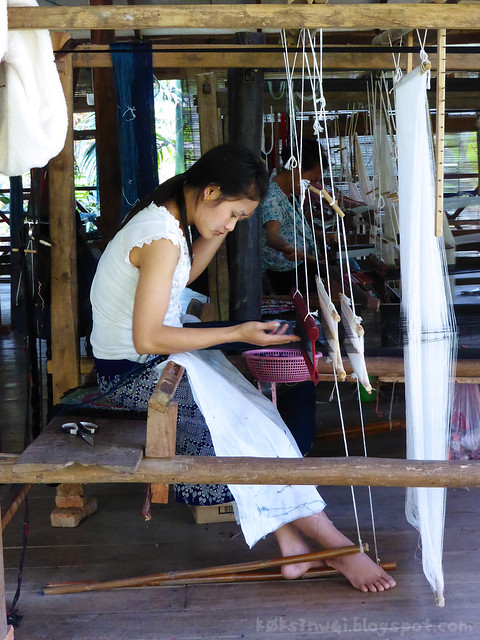 |
| Some of the in-house artisans, working a loom. |
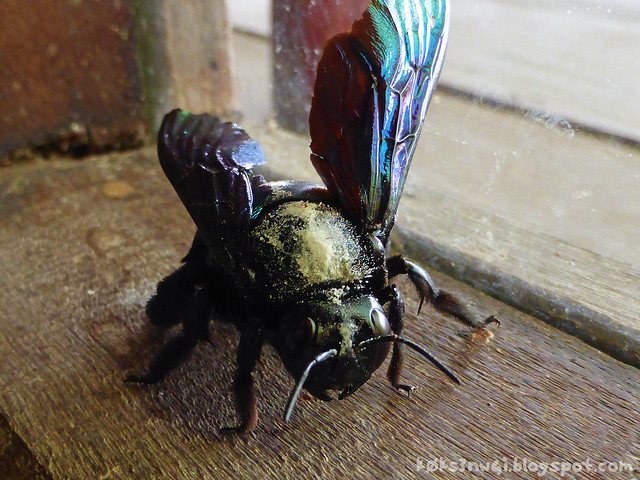 |
| A massive carpenter bee (Xylocopa sp.) which was stuck in the indigo dye exhibit above the cafe at Ock Pop Tock that was almost two inches in length. |
 |
| Dead domesticated silkmoths (Bombyx mori) with raw silk cocoons on display. |
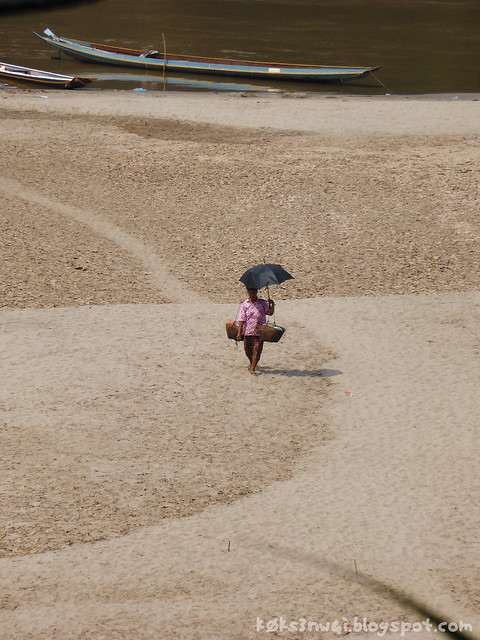 |
| A lady walking on a sand bar by the Mekong, as seen from the cafe at Ock Pop Tock. |
I went back briefly to our guesthouse after my visit to the Ock Pop Tock Living Crafts Centre to check up on how my lady love was holding up and to bring her lunch. After showering and taking a nap, I headed out again in evening to hunt for dinner food. On my walk, I dropped in on Wat Wisunarat, a temple build in 1513 during the reign of its namesake but it was already closed when I got there. The original was crafted from wood but after it was burnt to cinders by the Black Haw raiders who stormed Luang Prabang in 1887 so they learned their lesson and rebuilt one from stone.
 |
| Streamers on bamboo poles at the back of Wat Wisunarat. |
One of the most distinctive installations at Wat Wisunarat is the That Pathum which is more popularly known as That Makmo, or the "Watermelon Stupa" for obvious reasons.
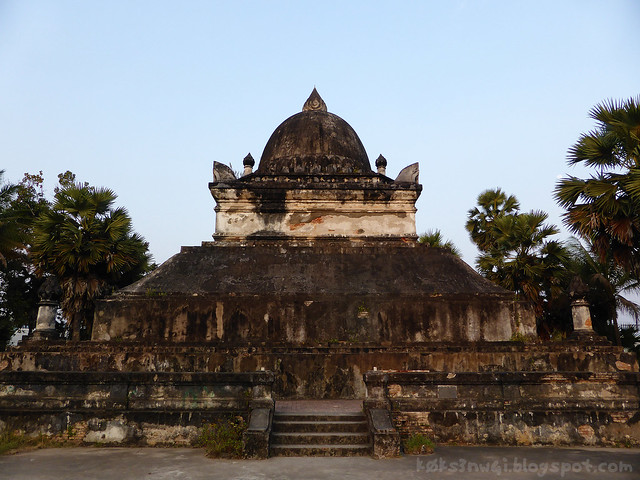 |
| That Pathum or That Makmo at Wat Wisunarat. |
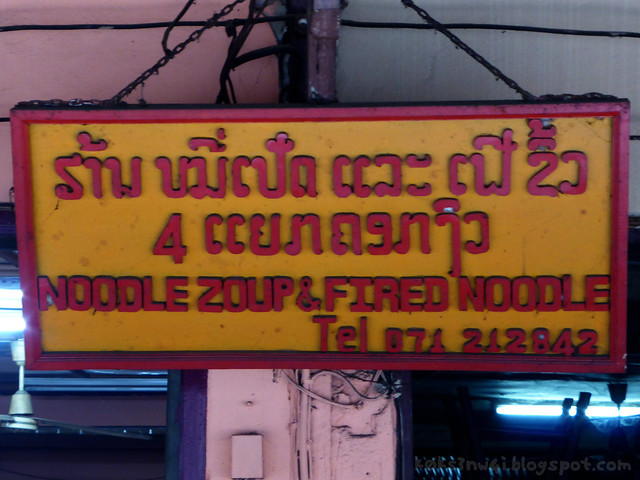 |
| Fun with Engrish. |
And thus concludes my brief day of exploration of the B-list attractions that the city of Luang Prabang has to offer. When we return, you will be reading about the two most unforgettable experiences we had in our last two days there.
RELATED POSTS:
Vive La Vientiane: Part One
Veni, Vidi, Vang Vieng: First Night in Town
Veni, Vidi, Vang Vieng: Climbing Pha Ngeun
Veni, Vidi, Vang Vieng: The Blue Lagoon at Tham Phu Kam
Veni, Vidi, Vang Vieng: Solo Mountain Biking Trip to Kaeng Nyui Waterfall
Veni, Vidi, Vang Vieng: Tubing Down the Nam Song
Veni, Vidi, Vang Vieng: Last Day in Town at Pha Poak and Lusi Cave
Sabaidee Luang Prabang: The Night and Morning MarketsSabaidee Luang Prabang: Phou Si Hill, Haw Kham and Wat Xieng Thong
Immune to diarrhoea,
k0k s3n w4i










